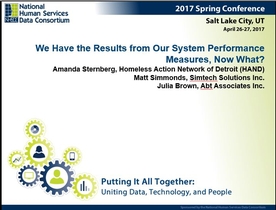Presented at: NHSDC Conference, Salt Lake City, UT
Presented on: 04/26/2017
During this session, we will provide an overview of how project-level performance measures, using count results culled from APRs and PIT reports, can serve as an effective alternative to large data warehouses that require client consent in order to co-mingle data. We will walk through the process we are taking in Detroit to ensure that the SPM results are valid, share how regional administrators can use project-level performance measures to identify both high and low performing projects, and share the Tableau reports we are using to help Detroit have a better understanding of the efficacy of the various projects in the area.
Detroit, like many regions, understands that HMIS is a treasure trove of information that is waiting to be unlocked. The Detroit CoC has a 96% adaption rate of HMIS and is able to comply with HUD requirements. However, HUD reports do not meet all the needs of various stakeholders in the region including the needs to drive policy, evaluate performance, identify gaps and tell the local stories about homelessness.
System Performance Measures (SPMs) are useful for highlighting areas in the City that are in need of attention but fall short however when it comes time to decide what action steps should be implemented to address the issues. The primary issue is that the results of the SPM reports lack context. Are the numbers an accurate reflection of what is happening in our region? Are the SPM report results good or bad? What projects are making the most significant impact on these SPM figures?

